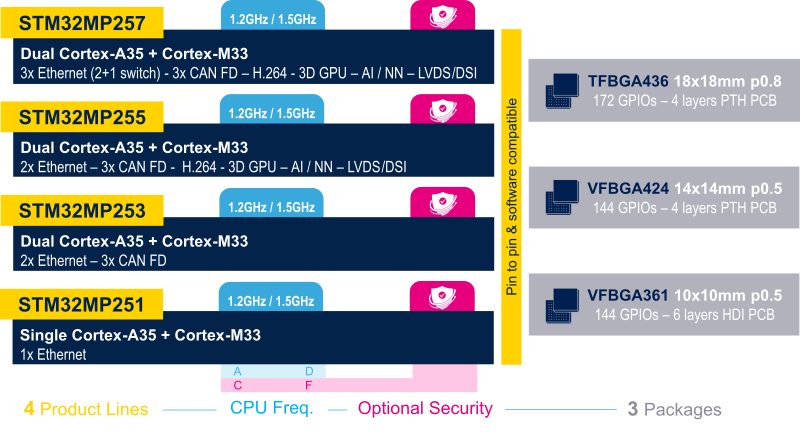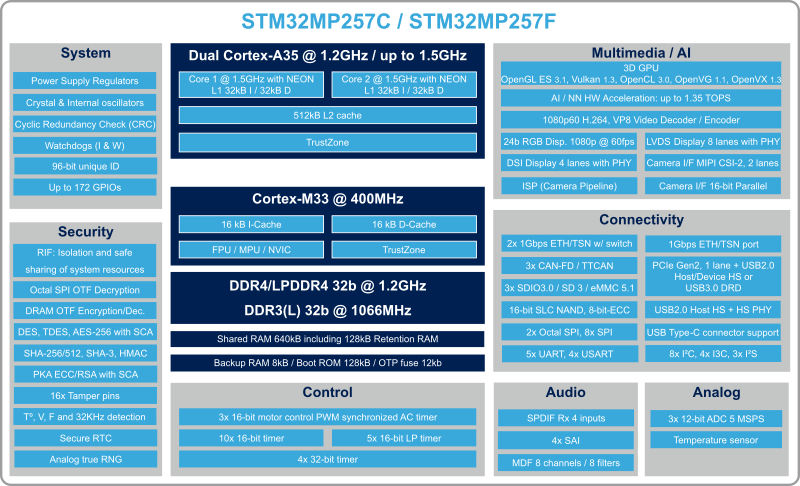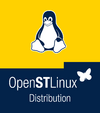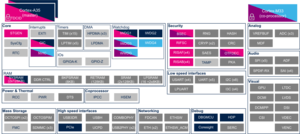Have you ever needed a microprocessor that can run a Linux application with a Full-HD display, while also handling isolated real-time tasks?
Do you need industrial interfaces? What if it could also embed state of the art security solutions?
And what if it could remain cold while running, so you don't care about cooling it?
The STM32MP25, built around a heterogenous architecture embedding an Arm® Cortex®-A35 dual core and an Arm® Cortex®-M33 coprocessor, may be your solution!
This article introduces the STM32MP25x lines ![]() , and gives information about the part number codification and block diagram. Then technical aspects are introduced, providing information on:
, and gives information about the part number codification and block diagram. Then technical aspects are introduced, providing information on:
- STM32MP25 documentation,
- articles dedicated to internal peripherals that make the transition towards the software frameworks required to control these peripherals,
- the list of boards supporting STM32MP25 microprocessors,
- the supported software distributions, that can be downloaded into the STM32MP25 microprocessors.
1. Introduction[edit | edit source]
STM32MP25 microprocessors are targeting industry 4.0 (with rich connectivity), human-machine interfaces (up to 1080p60), artificial Intelligence at the edge (up to 1.35 TOPS NPU) and a wide range of smart products that require a very high level of security, such as IoT and payment applications.
STM32MP25 microprocessors are based on a heterogenous architecture embedding an Arm® Cortex®-A35 dual core and an Arm® Cortex®-M33 coprocessor, both supporting Arm®Trustzone® mode for secure operations.
This microprocessor embeds graphics (GPU), video (VPU), and artificial intelligence (NPU) hardware accelerators to offload the Cortex cores with enhanced performance and power efficiency.
On top of this, it extends the connectivity inherited from the STM32MP1 series with high speed interfaces like PCIe/USB3, Gigabit ETH (with TSN support and integrated switch) and LVDS display interfaces (on top of DSI and RGB), that enlarge the possibilities in industrial, smart city and smart home applications.
The STM2MP25 also comes with a resource isolation framework (RIF) that is a very flexible and powerful infrastructure allowing to decide which Arm® Cortex® will boot first and to associate each peripheral to a hardware execution context or traffic initiator (like a DMA).
2. Part number codification[edit | edit source]
The figure below shows the differences between the four STM32MP25x lines, with their security and frequency options. Each line can be delivered in one of three packages represented on the right side: refer to the technical documentation to get details on the available features per package.

The tables below explains how the part numbers are encoded for all the above combinations.
2.1. STM32MP25x lines[edit | edit source]
Cortex-A35 Cortex-M33 GPU/NPU Video enc./dec.[1] Display FDCAN Gigabit Ethernet interfaces STM32MP257 Dual Yes Yes Yes TFT/DSI/LVDS 3 3 (2+1 switch) STM32MP255 Dual Yes Yes Yes TFT/DSI/LVDS 3 2 STM32MP253 Dual Yes No No TFT 3 2 STM32MP251 Single Yes No No TFT No 1
2.2. Security, Cortex-A35 frequency and GPU/NPU frequency[edit | edit source]
Security Cortex-A35 frequency GPU/NPU frequency[2] STM32MP25xA Basic 1200 MHz[3] 800 MHz STM32MP25xC Secure boot + Cryptography 1200 MHz[3] 800 MHz STM32MP25xD Basic 1500 MHz[3] 900 MHz STM32MP25xF Secure boot + Cryptography 1500 MHz[3] 900 MHz
2.3. Packages[edit | edit source]
STM32MP25xxAI TFBGA436, 18x18mm, pitch 0.8mm 172 GPIOs STM32MP25xxAK VFBGA424, 14x14mm, pitch 0.5mm 144 GPIOs STM32MP25xxAL VFBGA361, 10x10mm, pitch 0.5mm 144 GPIOs
2.4. Junction temperature[edit | edit source]
STM32MP25xxxx3 - 40 to + 125 °C
3. Block diagram[edit | edit source]
Here below is the STM32MP257F block diagram offering the richest features set of the STM32MP25 microprocessor.

The above figure shows a functional view of the design that does not aim to be aligned with the real design: it shows the available features and not how they are implemented into the microprocessor.
4. Technical documentation[edit | edit source]
- STM32MP25 reference manuals: device and internal peripheral user specifications
- STM32MP25 datasheets: electrical characteristics, package, and pinout descriptions
5. Internal peripherals[edit | edit source]
STM32MP25 peripherals overview article gives a description of all the internal peripherals available on STM32MP25 devices, with direct links to the articles where you can find:
- an overview of each peripheral,
- the list of instances available for each peripheral type,
- information on the way each instance can be shared between Arm® Cortex®-A35 and Cortex®-M33 cores,
- direct links to the software frameworks used to control the peripheral from different Arm® cores and security modes such as Cortex®-A35 non secure, Cortex®-A35 secure, Cortex®-M33 non secure, or Cortex®-M33 secure.
6. How to get further with STM32MP25 ecosystem[edit | edit source]
6.1. Boards[edit | edit source]
The list of boards that integrate STM32MP25 devices can be found in STM32MP25 boards article.
6.2. Supported software distributions[edit | edit source]
 STM32MPU Embedded Software distribution STM32MPU Embedded Software distribution
|
Click the links above to find information on:
- Distribution composition and associated software architecture
- Associated release notes
7. References and foot notes[edit | edit source]
- ↑ Video codecs: H.264/VP8 up 1920×1080 @60 fps
- ↑ Only for STM32MP255x and STM32MP257x
- ↑ 3.0 3.1 3.2 3.3 Exposure to maximum rating conditions for extended periods may affect device reliability. Device mission profile (application conditions) is compliant with JEDEC JESD47 qualification standard. Refer to the STM32MP25 datasheets and AN5729 for further information.
